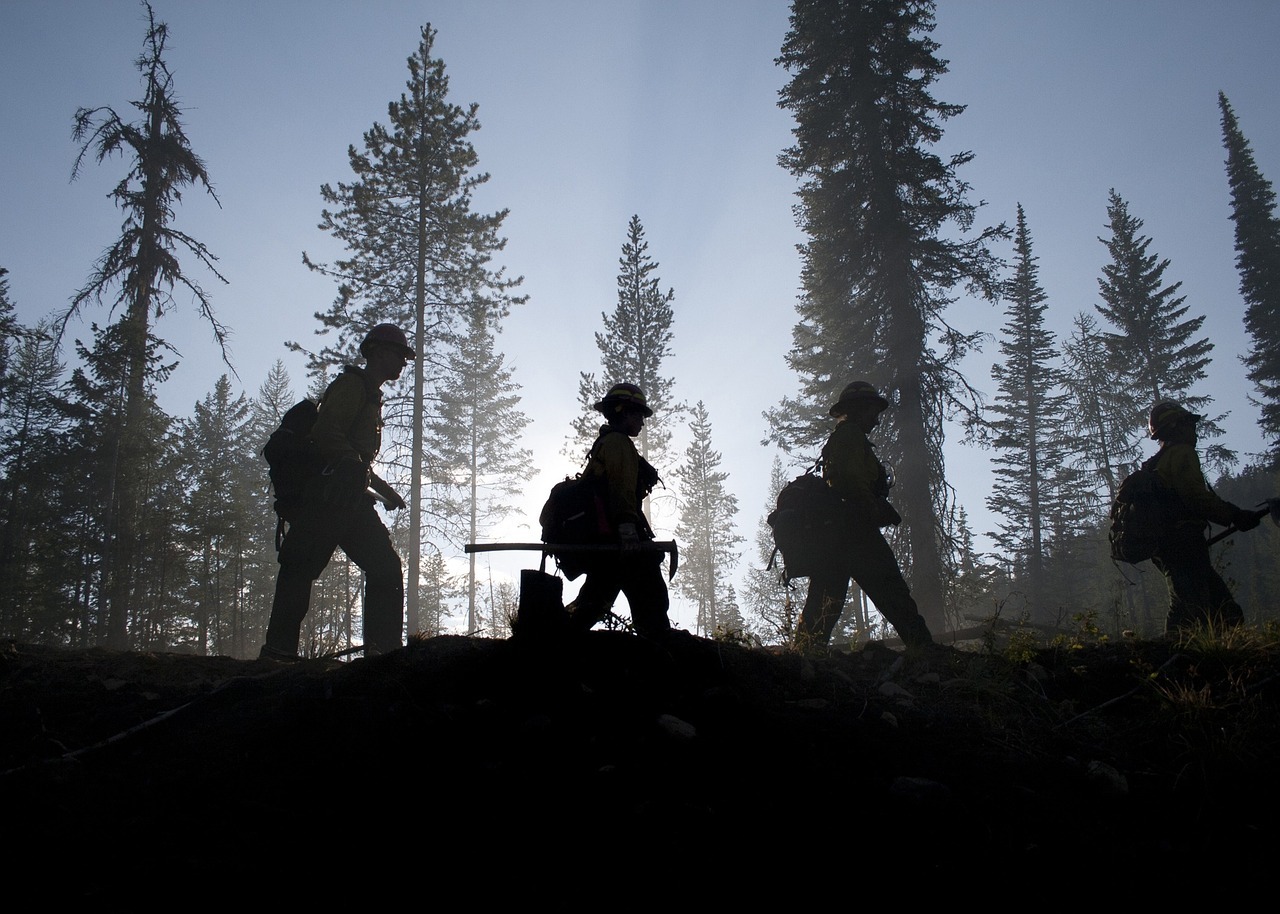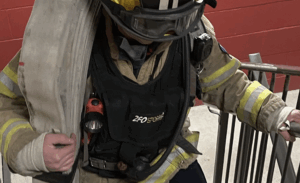In the vast expanse of nature’s grandeur, a silent but relentless guardian exists—the wildland firefighters. These dedicated individuals are the stalwart protectors of our forests, grasslands, and wilderness areas, braving wildfires’ unpredictable and formidable force.
At the heart of their mission lies a profound responsibility—to safeguard our natural landscapes and communities from the devastation wrought by uncontrolled blazes. Beyond the romanticized imagery lies a world of unyielding dedication, resilience, and unwavering commitment to a cause greater than oneself.
Understanding Their Role
Wildland firefighters are the frontline warriors in the battle against wildfires, deploying specialized skills, gear, and equipment to contain, suppress, and ultimately extinguish these infernos. Their tireless efforts extend beyond combating flames; they meticulously plan, strategize, and execute measures to mitigate the spread of wildfires, minimizing their impact on the environment and human habitats.
The Importance of Their Work
The significance of wildland firefighters’ work resonates deeply in the preservation of ecosystems, the protection of wildlife habitats, and the safeguarding of lives and properties. Their tireless dedication ensures the continuity of our natural heritage, mitigating the catastrophic effects of wildfires and fostering environmental resilience.
Join us in exploring the extraordinary realm of wildland firefighting—unveiling the unique lifestyle, indispensable gear, and critical equipment that enable these remarkable individuals to stand resolute in the face of nature’s most ferocious elements.
Table of Contents
The Wildland Firefighters Lifestyle
1. Daily Routine
The life of a wildland firefighter during the fire season is a testament to resilience and dedication. Each day dawns with readiness and anticipation, uncertain of the challenges ahead. The routine is defined by preparedness, adaptability, and an unwavering commitment to the mission.
- Morning Preparation: Mornings start early, often with physical conditioning and equipment checks. Fitness is not just a preference but a necessity, ensuring peak physical condition for the demanding tasks ahead.
- Deployment Readiness: Wildland firefighters remain on standby, poised for rapid deployment. Briefings on weather conditions, fire behavior forecasts, and strategic plans set the tone for the day’s operations.
- Firefighting Operations: Once deployed, their tasks vary—from constructing fire lines to conducting controlled burns or engaging directly with wildfires. Long hours of strenuous work, navigating rugged terrains and battling flames, define their day.
2. Challenges and Rewards
The life of a wildland firefighter is no stroll through the woods; it’s a continuous test of physical endurance, mental fortitude, and adaptability to nature’s whims.
- Challenges: Long hours under extreme conditions, exposure to smoke and hazardous terrain, and the unpredictability of wildfires pose immense challenges. Enduring these conditions demands resilience, as firefighters face physical exhaustion and emotional strain.
- Rewards: Amidst the challenges lie profound rewards—the camaraderie forged within firefighting teams, the satisfaction of containing a wildfire, and the deep sense of purpose derived from protecting nature and communities. Witnessing the resilience of nature’s rejuvenation post-fire is a poignant reward for their efforts.
The wildland firefighter lifestyle demands sacrifice, but it yields rewards beyond measure—the fulfillment of safeguarding our natural landscapes, the bonds forged in adversity, and the knowledge that their work is instrumental in preserving our environment.
Gear and Personal Protective Equipment (PPE) for Wildland Firefighters
Wildland firefighting demands specialized gear tailored to withstand the rigors of battling wildfires, ensuring the safety and effectiveness of firefighters.
Gear Overview
- Fire-resistant Clothing: Nomex or Kevlar-based gear offers flame-resistant properties, protecting against heat while allowing breathability.
- Boots: Sturdy, heat-resistant boots with thick soles shield against hot surfaces and embers.
- Helmets: Lightweight yet robust helmets with face shields safeguard against falling debris and radiant heat.
- Gloves: Heat-resistant gloves protect hands and allow safe handling of tools and equipment.
- Fire Shelter: A portable, heat-resistant emergency shelter is a last resort in extreme heat.
- Eye Protection: Goggles or safety glasses shield against smoke, ash, and debris.
Additional Equipment
- Hand Tools: Pulaskis, McLeods, and fire rakes aid in constructing fire lines and managing vegetation.
- Communication Devices: Radios and satellite phones enable team coordination.
- Water Delivery Systems: Pumps, hoses, and Smoke Chaser backpack water tanks facilitate water deployment for suppression.
- Personal Supplies: Essential items like CamelBak hydration pack, food, first aid kits, and emergency gear ensure readiness.
The gear and PPE used by wildland firefighters are meticulously designed, offering vital protection and functionality for effectively combating wildfires.
Tools and Equipment in Wildland Firefighting
Wildland firefighters rely on specialized hand tools and water delivery systems to manage wildfires effectively.
1. Hand Tools
Wildland firefighters rely on an array of specialized hand tools, each meticulously designed to assist in constructing fire lines, managing vegetation, and facilitating firefighting operations.
- Pulaski: A versatile tool featuring an axe blade on one side and an adze (hoe-like) blade on the other. Its dual functionality allows for chopping, digging, and scraping, making it invaluable for cutting through vegetation and digging trenches.
- McLeod: Combining a rake and hoe, the McLeod features a wide hoe-like blade on one side and a rake on the other. This tool excels in cutting through underbrush, raking debris, and building fire lines.
- Fire Rake: With its sharp teeth and sturdy design, the fire rake effectively clears brush and creates firebreaks, enhancing control over spreading wildfires.
2. Pumps and Hoses
Water delivery systems are pivotal in wildland firefighting, enabling firefighters to deploy water for suppression and strategic firefighting maneuvers.
- Pumps: Portable pumps, often powered by gas engines or other means, draw water from natural sources like rivers or portable tanks. They provide a pressurized water supply for hoses and other firefighting tools.
- Hoses: Lightweight yet durable hoses allow for the controlled delivery of water to target specific wildfire areas. They come in various lengths and diameters, facilitating flexible and efficient water delivery.
- Water Delivery Systems: These systems encompass a range of equipment, including backpack water tanks, water tenders, and hose lay strategies, ensuring a continuous and targeted water supply during firefighting operations.
Operational Significance
The efficacy of these tools and equipment lies not only in their design but in the skillful utilization by wildland firefighters. From hand tools enabling the creation of fire lines to pumps and hoses delivering vital water resources, each component forms an integral part of the arsenal wielded in the relentless battle against wildfires.
Vehicles and Technology in Wildland Firefighting
Wildland firefighting operations rely on a blend of specialized vehicles and cutting-edge technology, each playing a pivotal role in combating wildfires effectively.
1. Wildland Fire Vehicles
- Engines: These vehicles, also known as fire apparatus or fire trucks, are designed for off-road use. Equipped with powerful pumps and water tanks, engines transport firefighters and water to remote locations, enabling direct firefighting efforts.
- Helicopters: Invaluable aerial assets, helicopters provide rapid response and aerial support. Equipped with water buckets or tanks, they conduct water drops over inaccessible areas and transport personnel and equipment.
- Air Tankers: These fixed-wing aircraft are essential for aerial firefighting, delivering fire retardants or water to target specific areas, creating fire breaks, and suppressing flames.
2. Technology in Firefighting
- GPS (Global Positioning System): GPS technology aids in firefighters’ navigation and real-time location tracking, enabling efficient deployment and coordination, especially in vast and challenging terrains.
- Drones: Unmanned aerial vehicles with high-resolution cameras and sensors offer valuable situational awareness. Drones provide aerial views, assess fire behavior, and monitor remote or inaccessible areas, enhancing firefighting strategies.
- Fire Behavior Modeling: Advanced computer modeling and simulation techniques predict fire behavior, spread, and potential paths. This technology assists in devising proactive strategies for containment and evacuation, improving overall wildfire management.
Integrating vehicles tailored for rugged terrains and cutting-edge technology elevates the effectiveness and safety of wildland firefighting operations. These assets enable swift response, enhanced situational awareness, and strategic firefighting maneuvers, ultimately aiding in the containment and suppression of wildfires.
Fitness and Training for Wildland Firefighters
1. Physical Fitness Requirements
Wildland firefighting demands peak physical conditioning to withstand the strenuous demands of the job and navigate challenging terrains. The position requires a high fitness level to ensure firefighters’ safety and effectiveness.
- Fitness Standards: The job entails arduous tasks like carrying heavy equipment, hiking with loads, and working in extreme conditions. Physical fitness tests assess endurance, strength, agility, and cardiovascular fitness, ensuring candidates can meet the demands of firefighting operations.
- Maintaining Fitness: Firefighters exercise regular physical training, focusing on strength, endurance, and flexibility. Activities include cardio exercises, strength training, hiking with weighted packs, and drills simulating firefighting scenarios.
2. Training Programs
- Overview of Training: Becoming a wildland firefighter involves completing specialized training programs and obtaining certifications.
- Basic Firefighter Training: Entry-level training covers firefighting techniques, safety protocols, equipment use, fire behavior, and tactics for managing wildfires.
Do you want to know how to become a wildland firefighter? Read How to Become a Wildland Firefighter: A Comprehensive Guide.
- Certifications: Various certifications, such as the Incident Qualification Card (Red Card) and the S-130/S-190 Firefighter Training, are essential, demonstrating proficiency in basic firefighting skills and safety protocols.
Do you want to know the requirements to become a city full-time firefighter? Read Firefighter Hiring Requirements and Preferences Explained.
Wildland firefighting training programs emphasize theoretical knowledge, practical skills, and physical fitness to equip individuals with the competence and readiness to combat wildfires effectively.
Safety Protocols and Emergency Response in Wildland Firefighting
1. Safety Measures
Wildland firefighting operates under stringent safety protocols to safeguard the well-being of firefighters in the face of extreme conditions and hazardous environments.
- Safety Protocols: Before deployment, thorough briefings on weather conditions, fire behavior forecasts, and tactical plans are conducted. Firefighters are trained to constantly monitor their surroundings, assess risks, and adhere to operation safety guidelines.
- Personal Protective Equipment (PPE): Ensuring proper use of fire-resistant clothing, helmets, gloves, and goggles is paramount. Regular equipment checks and maintenance are mandatory to mitigate potential hazards.
- Communication and Coordination: Effective communication among firefighting teams is essential. Radios, satellite phones, and other communication devices facilitate real-time updates and coordination to ensure smooth operations.
2. Emergency Response
- Procedures for Emergencies: Wildland firefighters undergo rigorous training in handling emergencies, medical situations, and evacuation procedures.
- Medical Situations: Firefighters receive training to address injuries, heat-related illnesses, and other medical emergencies. Basic life support skills and first aid are crucial components of their training.
- Evacuation Protocols: Contingency plans for emergencies include clear evacuation procedures. Firefighters are trained to identify escape routes, safe zones, and protocols for rapid evacuation in case of sudden changes in fire behavior or other unforeseen circumstances.
- Deployment Safety: Wildland firefighting teams are briefed on escape routes, safety zones, and rendezvous points before deployment. Regular check-ins and monitoring ensure everyone’s safety during operations.
Wildland firefighting prioritizes the safety of personnel through rigorous safety protocols, comprehensive training in emergency response, and a proactive approach to mitigate risks and ensure a swift, coordinated response in critical situations.
Environmental Impact and Conservation Efforts
1. Impact on Ecosystems
- Ecological Impact: Wildfires, while a natural phenomenon, can have significant ecological impacts. They can alter landscapes, disrupt ecosystems, and affect biodiversity. However, they also play a vital role in rejuvenating ecosystems by clearing dead vegetation, promoting new growth, and enriching soil.
- Role of Firefighters: Wildland firefighters play a crucial role in ecosystem preservation. Their efforts focus on containing wildfires, mitigating their spread, and minimizing damage to critical habitats. By managing fire intensity and strategically controlling the blaze, they aim to preserve the integrity of ecosystems.
2. Prescribed Burns
- Controlled Burns: Prescribed burns are deliberate fires initiated under controlled conditions to clear underbrush, reduce fuel loads, and manage vegetation. These intentional fires mimic natural processes, enhancing forest health and reducing the risk of uncontrolled wildfires.
- Importance: Prescribed burns serve multiple purposes. They eliminate accumulated debris, rejuvenate soil, promote new growth, and maintain a balanced ecosystem. Additionally, they mitigate the risk of catastrophic wildfires by reducing the available fuel, thus preventing the uncontrolled spread of flames.
- Ecosystem Management: Fire management strategies involving prescribed burns are instrumental in maintaining healthy ecosystems. They aid in restoring natural fire regimes, fostering biodiversity, and preserving habitats for various plant and animal species.
Wildland firefighters, through their efforts to contain wildfires and implement controlled burns, play a vital role in balancing the ecological impact of fires. Their strategic interventions aim to preserve ecosystems, promote biodiversity, and prevent the devastation caused by uncontrolled wildfires.
Career and Community Impact in Wildland Firefighting
Career Paths: Wildland firefighting offers diverse career opportunities for individuals passionate about environmental stewardship and public safety. Aspiring firefighters can pursue various roles, starting from entry-level positions as firefighters and progressing to leadership roles such as crew supervisors, fire management specialists, incident commanders, or fire ecologists. Advanced training and certifications open doors to specialized fire prevention, research, and management positions within governmental agencies, private organizations, or academia.
Community Engagement: Wildland firefighters are integral to community safety and resilience. Their efforts in mitigating wildfires protect natural landscapes and safeguard homes, infrastructure, and livelihoods. Beyond firefighting, community engagement involves public education on fire safety, organizing evacuation plans, and collaborating with local authorities to raise awareness about wildfire prevention and preparedness. This proactive engagement fosters stronger community ties, promotes safety awareness, and builds trust between firefighting agencies and the public.
The career opportunities in wildland firefighting extend beyond fighting fires, offering diverse professional growth and specialization paths. Close engagement with communities also ensures a proactive approach to wildfire prevention and safety, fostering stronger, safer neighborhoods.
If you’re interested in becoming a wildland firefighter? Read How to Become a Wildland Firefighter: A Comprehensive Guide.
Conclusion
From the rugged terrains they traverse to the relentless battle against wildfires, the world of wildland firefighters is a testament to unwavering dedication, resilience, and commitment.
This exploration into their lifestyle, gear, and equipment reveals the pivotal role played by these remarkable individuals. They’re physically demanding yet rewarding daily routines underscore the importance of peak fitness and preparedness.
Hand in hand with their specialized tools and technology, wildland firefighters navigate the challenges of nature’s unpredictability. Their proficiency in utilizing equipment and cutting-edge technology forms a formidable arsenal in the relentless battle against wildfires.
Wildland firefighters’ lifestyle, gear, and equipment converge as a testament to their courage, readiness, and unwavering commitment to protecting our natural landscapes and communities from the destructive force of wildfires.
Learn How You Can Become A Firefighter

Mastering the Firefighter Exam is a complete guide on how to pass the firefighter exam with a top score. It simplifies the complicated hiring practices of big city fire departments and reveals insider information most candidates don’t know about.
If You Would Like To Know How To Get A Head Of Your Competition, This Book Is For You.







